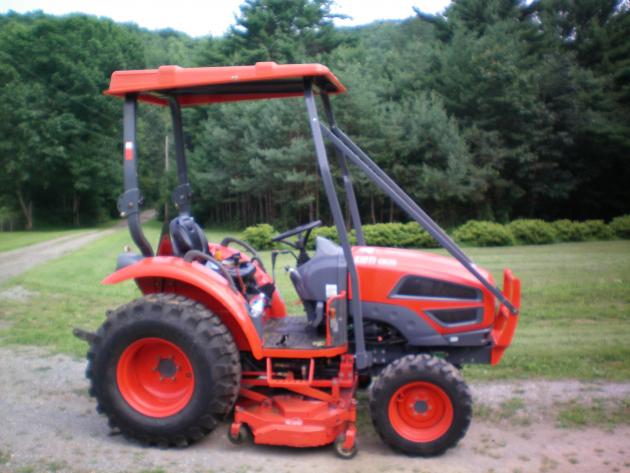Use the following format to cite this article:
Agricultural vehicles in the woods. (2014) Farm and Ranch eXtension in Safety and Health (FReSH) Community of Practice. Retrieved from http://articles.extension.org/pages/70337/agricultural-vehicles-in-the-w….
The risk of safety related incidents is high when a farmer or rancher uses a farm tractor to cut trees, clear fence rows, and gather firewood. The typical farm tractor is simply not designed for use in woodlots. A farm tractor lacks the safety components of timber harvest tractors or skidders, which include the following:
- A heavy steel skid plate to protect the underside of the machine
- A protective radiator grill
- Engine side guards
- 10- to 12-ply flat sidewall tires
- Tire chains
- Front-end weights
- A 10-pound ABC fire extinguisher
- A spark-arrester exhaust system
- A category II falling object projective structure (FOPS) with a seat belt
- A protective grill for the rear window and sides of the FOPS cab
- High ground clearance
- Lateral stability
- Nearly equal front- and rear-axle weight distribution.
The photo below is an example of a tractor equipped with a Rollover Protective Structure (ROPS) and FOPS.

(Source: Lee Stover, L & E Stover Enterprises)
Dangerous Farm Tractor Usage
A rear overturn incident can occur with a farm tractor if a chain or cable is attached to a point higher on the tractor than the drawbar. Side overturn can occur when the farm tractor runs over a stump, rock, or tree trunk with a rear tire. Farm tractors equipped with a front-end loader should never be used to pull or push down limbs because the raised loader changes the center or gravity, placing the tractor at risk for a side overturn incident. Never use a farm tractor to complete forestry jobs such as pushing, dragging, or loading logs, without skid cones, log arches, three-point mounted grapples, or a skidding implement equipped with a three-point winch. These pieces of equipment reduce the risk of a log twisting or rolling out of the control while being dragged. Click here for more information on safe hitching.
All-Terrain Vehicles (ATVs) and Utility Vehicles (UTVs)
The potential for a tractor, ATV, or UTV overturn exists in woodlots because of uneven terrain and hidden obstacles such as rocks, roots, and stumps. Only specialized equipment such as timber harvest tractors and skidders should be used in woodlots. Felling of large trees for harvest should be completed by commercial operators with specialized equipment. Once a tree has been felled and located in a non-wooded area such as a fence row, the tree can be properly delimbed and sectioned for use on the farm or ranch. In order to remove the wood, you need to determine the best mode of transportation for the job and the environment.
ATVs towing wagons and UTVs with cargo beds or boxes continue to be popular choices, but it is important to understand their limitations. ATVs typically have lighter-duty suspension systems with less pulling and braking power, making them unsafe to complete most logging-type tasks. Some larger UTVs with a wider wheel base are equipped with a heavier frame and protective cage but still have limited capability in wooded areas.
When using a UTV or ATV to pull a trailer, the operator should be careful to observe the hauling capacity limits to reduce the risk of an incident. Check the manufacturer’s recommendation for any trailer that is being used to haul wood. Do not overload the trailer, and make sure that the wood is properly secured. The cargo box for each UTV has a recommended payload capacity that can vary between 500 and 1,400 pounds, depending on the make and model. It is extremely important to check the operator’s manual to determine the maximum payload capacity for your UTV. Keeping loads within the recommended payload capacity is essential to reducing the risk of an accident or potential damage to the UTV or ATV and trailer.
Extra precautions should be taken when using ATVs and UTVs in the woods for any activity. By hauling smaller amounts of wood slowly through a woodlot or along a trail that has been inspected for hidden obstacles, you can decrease the potential for an incident. Log arches can be used to stabilize smaller logs that need to be dragged from the woods, while reducing the possibility of the butt end of the log catching on a rock or stump or rolling sideways down uneven, sloping terrain. Consider winching logs that have fallen into precarious positions to a safer landing before using a light-duty ATV or UTV to pull them. The photo below shows an ATV using a log arch to safely transport logs on a path.

Additional Safety Recommendations:
- If you are in the woods, inform other people of your location.
- Always know the location of other people in your group, especially when felling a tree.
- Make sure you have a complete first aid kit with you and have a basic understanding of first aid for severe bleeding, second-degree burns, and shock.
Resources
Click here to learn more about using your ATV on a farm or ranch.
Click here to learn more about chain saw safety.
Use the following format to cite this article:
Agricultural vehicles in the woods. (2014) Farm and Ranch eXtension in Safety and Health (FReSH) Community of Practice. Retrieved from http://articles.extension.org/pages/70337/agricultural-vehicles-in-the-w….
Sources
Murphy, D., Stover, L., & Harshman, W. (2011) Tractors in the woods. Penn State Extension. Retrieved from https://extension.psu.edu/tractors-in-the-woods.
